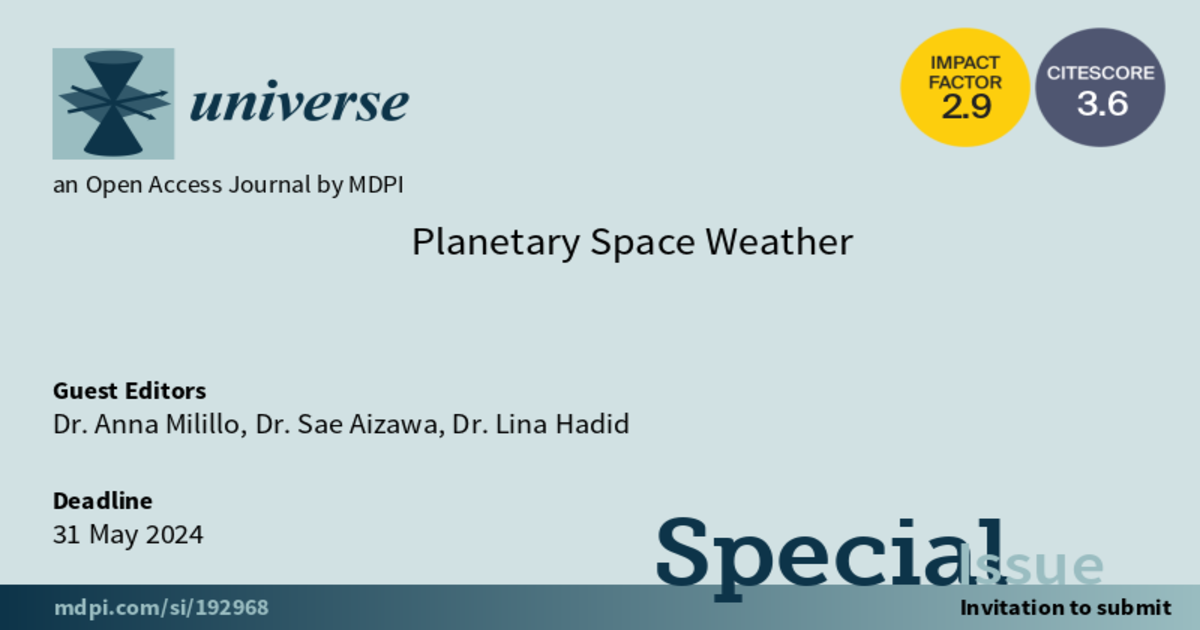Planetary Space Weather
A special issue of Universe (ISSN 2218-1997). This special issue belongs to the section "Planetary Sciences".
Deadline for manuscript submissions: 31 May 2024 | Viewed by 426

Special Issue Editors
Interests: planetary space weather; exospheres; magnetospheres; interactions with environment and surfaces
Interests: planets; planetary science; magnetosphere; spacecraft; solar wind; space physics; space plasma physics; magnetospheric physics; plasma simulation; numerical simulation; plasma kinetics; magnetohydrodynamics; plasma; plasma instabilities
Interests: study of micro and macro-physical processes in space plasmas; study of the Outer planet’s upper atmospheres
Special Issue Information
Dear Colleagues,
Planetary space weather refers to the study of the variability of planetary (or satellite) environments determined by the variability of the solar activity and/or the interplanetary space dynamics (and/or the dynamics of the magnetosphere in which the Solar System body may be embedded) (Plainaki et al., 2016).
It involves the monitoring and analysis of solar activity, solar wind, interplanetary, and magnetospheric phenomena and their short-term effects on ionospheres, exospheres, atmospheres, and planet surfaces, but also on human-made devices in space like satellites and instrumentations.
This Special Issue is devoted to recent progress in space weather research, including results from space missions and ground-based observations. The focus will be on magnetized bodies as well as unmagnetized ones and bodies with or without an atmosphere. The considered environments could be the interplanetary medium as well as the magnetospheric environment of the parent planet (in the case of the moons of the giant planets). Studies of the exoplanet interactions with their parent star are also included in this Special Issue. Studies of radiation effects on technological devices are also welcome.
We invite researchers and scientists with expertise in planetary space weather to submit their original research articles and review papers to this Special Issue.
Dr. Anna Milillo
Dr. Sae Aizawa
Dr. Lina Hadid
Guest Editors
Manuscript Submission Information
Manuscripts should be submitted online at www.mdpi.com by registering and logging in to this website. Once you are registered, click here to go to the submission form. Manuscripts can be submitted until the deadline. All submissions that pass pre-check are peer-reviewed. Accepted papers will be published continuously in the journal (as soon as accepted) and will be listed together on the special issue website. Research articles, review articles as well as short communications are invited. For planned papers, a title and short abstract (about 100 words) can be sent to the Editorial Office for announcement on this website.
Submitted manuscripts should not have been published previously, nor be under consideration for publication elsewhere (except conference proceedings papers). All manuscripts are thoroughly refereed through a single-blind peer-review process. A guide for authors and other relevant information for submission of manuscripts is available on the Instructions for Authors page. Universe is an international peer-reviewed open access monthly journal published by MDPI.
Please visit the Instructions for Authors page before submitting a manuscript. Submitted papers should be well formatted and use good English. Authors may use MDPI's English editing service prior to publication or during author revisions.
Keywords
- space weather
- planetary environment
- solar–planet interactions
- sun activity
- magnetosphere dynamics






